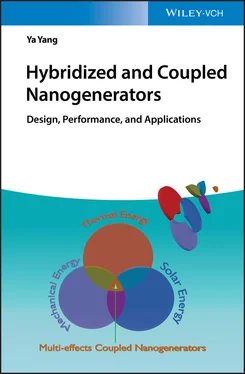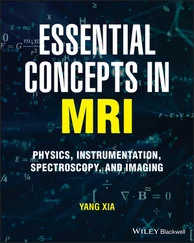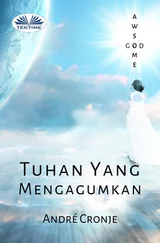Ya Yang - Hybridized and Coupled Nanogenerators
Здесь есть возможность читать онлайн «Ya Yang - Hybridized and Coupled Nanogenerators» — ознакомительный отрывок электронной книги совершенно бесплатно, а после прочтения отрывка купить полную версию. В некоторых случаях можно слушать аудио, скачать через торрент в формате fb2 и присутствует краткое содержание. Жанр: unrecognised, на английском языке. Описание произведения, (предисловие) а так же отзывы посетителей доступны на портале библиотеки ЛибКат.
- Название:Hybridized and Coupled Nanogenerators
- Автор:
- Жанр:
- Год:неизвестен
- ISBN:нет данных
- Рейтинг книги:3 / 5. Голосов: 1
-
Избранное:Добавить в избранное
- Отзывы:
-
Ваша оценка:
- 60
- 1
- 2
- 3
- 4
- 5
Hybridized and Coupled Nanogenerators: краткое содержание, описание и аннотация
Предлагаем к чтению аннотацию, описание, краткое содержание или предисловие (зависит от того, что написал сам автор книги «Hybridized and Coupled Nanogenerators»). Если вы не нашли необходимую информацию о книге — напишите в комментариях, мы постараемся отыскать её.
Hybridized and Coupled Nanogenerators — читать онлайн ознакомительный отрывок
Ниже представлен текст книги, разбитый по страницам. Система сохранения места последней прочитанной страницы, позволяет с удобством читать онлайн бесплатно книгу «Hybridized and Coupled Nanogenerators», без необходимости каждый раз заново искать на чём Вы остановились. Поставьте закладку, и сможете в любой момент перейти на страницу, на которой закончили чтение.
Интервал:
Закладка:
7 7 Chong, W., Fazlizan, A., Poh, S. et al. (2012). Early development of an innovative building integrated wind, solar and rain water harvester for urban high rise application. Energy Build. 47: 201.
8 8 Hoogwijk, M., de Vries, B., and Turkenburg, W. (2004). Assessment of the global and regional geographical, technical and economic potential of onshore wind energy. Energy Econ. 26: 889.
9 9 Sfetsos, A. (2000). A comparison of various forecasting techniques applied to mean hourly wind speed time series. Renewable Energy 21: 23.
10 10 Seguro, J. and Lambert, T. (2000). Modern estimation of the parameters of the Weibull wind speed distribution for wind energy analysis. J. Wind Eng. Ind. Aerodyn. 85: 75.
11 11 Al‐Bahadly, I. (2009). Building a wind turbine for rural home. Renewable Sustainable Energy Rev. 13: 159.
12 12 Walker, S.L. (2011). Building mounted wind turbines and their suitability for the urban scale – a review of methods of estimating urban wind resource. Energy Build. 43: 1852.
13 13 Ricciardelli, F. and Polimeno, S. (2006). Some characteristics of the wind flow in the lower urban boundary layer. J. Wind Eng. Ind. Aerodyn. 94: 815.
14 14 Schallenberg‐Rodriguez, J. (2013). A methodological review to estimate techno‐economical wind energy production. Renewable Sustainable Energy Rev. 21: 272.
15 15 Herbert, G.J., Iniyan, S., Sreevalsan, E., and Rajapandian, S. (2007). A review of wind energy technologies. Renewable Sustainable Energy Rev. 11: 1117.
16 16 Safari, B. and Gasore, J. (2010). A statistical investigation of wind characteristics and wind energy potential based on the Weibull and Rayleigh models in Rwanda. Renewable Energy 35: 2874.
17 17 Mithraratne, N. (2009). Roof‐top wind turbines for microgeneration in urban houses in New Zealand. Energy Build. 41: 1013.
18 18 Fan, F.‐R., Tian, Z.‐Q., and Wang, Z.L. (2012). Flexible triboelectric generator. Nano Energy 1: 328.
19 19 Wang, S., Lin, L., and Wang, Z.L. (2012). Nanoscale triboelectric‐effect‐enabled energy conversion for sustainably powering portable electronics. Nano Lett. 12: 6339.
20 20 Yang, Y., Zhang, H., Chen, J. et al. (2013). Single‐electrode‐based sliding triboelectric nanogenerator for self‐powered displacement vector sensor system. ACS Nano 7: 7342.
21 21 Niu, S., Liu, Y., Wang, S. et al. (2013). Theory of sliding‐mode triboelectric nanogenerators. Adv. Mater. 25: 6184.
22 22 Wang, S., Lin, L., Xie, Y. et al. (2013). Sliding‐triboelectric nanogenerators based on in‐plane charge‐separation mechanism. Nano Lett. 13: 2226.
23 23 Niu, S., Wang, S., Lin, L. et al. (2013). Theoretical study of contact‐mode triboelectric nanogenerators as an effective power source. Energy Environ. Sci. 6: 3576.
24 24 Liu, Y., Niu, S., and Wang, Z.L. (2015). Theory of tribotronics. Adv. Electron. Mater. 1: 1500124.
25 25 Zhu, G., Peng, B., Chen, J. et al. (2015). Triboelectric nanogenerators as a new energy technology: from fundamentals, devices, to applications. Nano Energy 14: 126.
26 26 Dharmasena, R.D.I.G., Jayawardena, K., Mills, C. et al. (2017). Triboelectric nanogenerators: providing a fundamental framework. Energy Environ. Sci. 10: 1801.
27 27 Wang, Z.L. (2015). Triboelectric nanogenerators as new energy technology and self‐powered sensors–principles, problems and perspectives. Faraday Discuss. 176: 447.
28 28 Ishugah, T., Li, Y., Wang, R., and Kiplagat, J. (2014). Advances in wind energy resource exploitation in urban environment: a review. Renewable Sustainable Energy Rev. 37: 613–626.
29 29 Grant, I., Mo, M., Pan, X. et al. (2000). An experimental and numerical study of the vortex filaments in the wake of an operational, horizontal‐axis, wind turbine. J. Wind Eng. Ind. Aerodyn. 85: 177.
30 30 Ayhan, D. and Sağlam, Ş. (2012). A technical review of building‐mounted wind power systems and a sample simulation model. Renewable Sustainable Energy Rev. 16: 1040.
31 31 Gordeeva, L., Restuccia, G., Cacciola, G., and Aristov, Y.I. (1998). Selective water sorbents for multiple applications, 5. LiBr confined in mesopores of silica gel: sorption properties. Kinet. Catal. 63: 81–88.
32 32 Yang, Y., Zhu, G., Zhang, H. et al. (2013). Triboelectric nanogenerator for harvesting wind energy and as self‐powered wind vector sensor system. ACS Nano 7: 9461.
33 33 Wang, S., Mu, X., Yang, Y. et al. (2015). Flow‐driven triboelectric generator for directly powering a wireless sensor node. Adv. Mater. 27 (2): 240.
34 34 Wang, S., Mu, X., Wang, X. et al. (2015). Elasto‐aerodynamics‐driven triboelectric nanogenerator for scavenging air‐flow energy. ACS Nano 9: 9554.
35 35 Xie, Y., Wang, S., Lin, L. et al. (2013). Rotary triboelectric nanogenerator based on a hybridized mechanism for harvesting wind energy. ACS Nano 7: 7119.
36 36 Zhang, H., Wang, J., Xie, Y. et al. (2016). Self‐powered, wireless, remote meteorologic monitoring based on triboelectric nanogenerator operated by scavenging wind energy. ACS Appl. Mater. Interfaces 8: 32649.
37 37 Bae, J., Lee, J., Kim, S. et al. (2014). Flutter‐driven triboelectrification for harvesting wind energy. Nat. Commun. 5: 4929.
38 38 Ren, X., Fan, H., Wang, C. et al. (2018). Wind energy harvester based on coaxial rotatory freestanding triboelectric nanogenerators for self‐powered water splitting. Nano Energy 50: 562.
39 39 Quan, Z., Han, C.B., Jiang, T., and Wang, Z.L. (2016). Robust thin films‐based triboelectric nanogenerator arrays for harvesting bidirectional wind energy. Adv. Energy Mater. 6: 1501799.
40 40 Wang, J., Ding, W., Pan, L. et al. (2018). Self‐powered wind sensor system for detecting wind speed and direction based on a triboelectric nanogenerator. ACS Nano 12: 3954.
41 41 Zhang, L., Zhang, B., Chen, J. et al. (2016). Lawn structured triboelectric nanogenerators for scavenging sweeping wind energy on rooftops. Adv. Mater. 28: 1650.
42 42 Zhao, Z., Pu, X., Du, C. et al. (2016). Freestanding flag‐type triboelectric nanogenerator for harvesting high‐altitude wind energy from arbitrary directions. ACS Nano 10: 1780.
43 43 Klemm, D., Heublein, B., Fink, H.P., and Bohn, A. (2005). Cellulose: fascinating biopolymer and sustainable raw material. Angew. Chem. Int. Ed. 44: 3358.
44 44 Kalia, S., Dufresne, A., Cherian, B.M. et al. (2011). Cellulose‐based bio‐and nanocomposites: a review. Int. J. Polym. Sci. 2011: 837875.
45 45 Moon, R.J., Martini, A., Nairn, J. et al. (2011). Cellulose nanomaterials review: structure, properties and nanocomposites. Chem. Soc. Rev. 40: 3941.
46 46 Siró, I. and Plackett, D. (2010). Microfibrillated cellulose and new nanocomposite materials: a review. Cellulose 17: 459.
47 47 Klemm, D., Kramer, F., Moritz, S. et al. (2011). Nanocelluloses: a new family of nature‐based materials. Angew. Chem. Int. Ed. 50: 5438.
48 48 Eichhorn, S.J., Dufresne, A., Aranguren, M. et al. (2010). Current international research into cellulose nanofibres and nanocomposites. J. Mater. Sci. 45: 1.
49 49 Hubbe, M.A., Rojas, O.J., and Lucia, L.A. (2015). Green modification of surface characteristics of cellulosic materials at the molecular or nano scale: a review. BioResources 10: 6095.
50 50 Hubbe, M.A. (2006). Bonding between cellulosic fibers in the absence and presence of dry‐strength agents – a review. BioResources 1: 281.
51 51 Chen, B., Yang, N., Jiang, Q. et al. (2018). Transparent triboelectric nanogenerator‐induced high voltage pulsed electric field for a self‐powered handheld printer. Nano Energy 44: 468.
52 52 Kim, H.‐J., Yim, E.‐C., Kim, J.‐H. et al. (2017). Bacterial nano‐cellulose triboelectric nanogenerator. Nano Energy 33: 130.
53 53 Yao, C., Hernandez, A., Yu, Y. et al. (2016). Triboelectric nanogenerators and power‐boards from cellulose nanofibrils and recycled materials. Nano Energy 30: 103.
Читать дальшеИнтервал:
Закладка:
Похожие книги на «Hybridized and Coupled Nanogenerators»
Представляем Вашему вниманию похожие книги на «Hybridized and Coupled Nanogenerators» списком для выбора. Мы отобрали схожую по названию и смыслу литературу в надежде предоставить читателям больше вариантов отыскать новые, интересные, ещё непрочитанные произведения.
Обсуждение, отзывы о книге «Hybridized and Coupled Nanogenerators» и просто собственные мнения читателей. Оставьте ваши комментарии, напишите, что Вы думаете о произведении, его смысле или главных героях. Укажите что конкретно понравилось, а что нет, и почему Вы так считаете.












